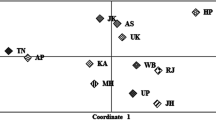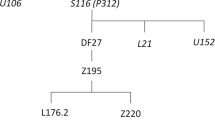Abstract
Linguistic evidence suggests that West Asia and Central Asia have been the two major geographical sources of genes in the contemporary Indian gene pool. To test the nature and extent of similarities in the gene pools of these regions we have collected DNA samples from four ethnic populations of northern India, and have screened these samples for a set of 18 Y-chromosome polymorphic markers (12 unique event polymorphisms and six short tandem repeats). These data from Indian populations have been analysed in conjunction with published data from several West Asian and Central Asian populations. Our analyses have revealed traces of population movement from Central Asia and West Asia into India. Two haplogroups, HG-3 and HG-9, which are known to have arisen in the Central Asian region, are found in reasonably high frequencies (41.7% and 14.3% respectively) in the study populations. The ages estimated for these two haplogroups are less in the Indian populations than those estimated from data on Middle Eastern populations. A neighbour-joining tree based on Y-haplogroup frequencies shows that the North Indians are genetically placed between the West Asian and Central Asian populations. This is consistent with gene flow from West Asia and Central Asia into India.
Similar content being viewed by others
References
Bhattacharyya N., Basu P., Das M., Pramanik S., Banerjee R. Roy B., Roychoudhury S and Majumder P. P. 1999 Negligible male gene-flow across ethnic boundaries in India, revealed by analysis of Y-chromosomal DNA polymorphisms.Genome Res. 9, 711–719.
Cann R. L. 2001 Genetic clues to dispersal of human populations: retracing the past from the present.Science 291, 1742–1748.
Casalotti E., Simoni L., Belledi M. and Barbujani G. 1999 Y-chromosome polymorphisms and the origins of the European gene pool.Proc. R. Soc. London B266, 1959–1965.
Casanova M., Leroy P., Boucekkine C., Weissenbach J., Bishop C., Fellous M., Purrello M., Fiori G. and Siniscalco M. 1985 A human Y-linked DNA polymorphism and its potential for estimating genetic and evolutionary distance.Science 230, 1403–1406.
Cavalli-Sforza L. L., Piazza A. and Menozzi P. 1994The history and geography of human genes. Princeton University Press. Princeton.
Hammer M. F., Karafet T., Rasanayagam A., Wood E. T., Altheide T. K., Jenkins T., Griffiths R. C., Templeton A. R. and Zegura S. L. 1998 Out of Africa and back again: nested cladistic analysis of human Y chromosome variation.Mol. Biol. Evol. 15, 427–441.
Hammer M. F., Redd A. J., Wood E. T., Bonner M. R., Jarjanazi H., Karafet T.et al. 2000 Jewish and Middle Eastern non-Jewish populations share a common pool of Y-chromosome biallelic haplotypes.Proc. Natl. Acad. Sci. USA 97, 6769–6774.
Hill E. Q., Jobling M. A. and Bradley D. G. 2000 Y-chromosome variation and Irish origins.Nature 404, 351–352.
Hurles M. E., Veitia R., Arroyo E., Armenteros M., Bertranpetit J., Perez-Lezaun A.et al. 1999 Recent male-mediated gene flow over a linguistic barrier in Iberia, suggested by analysis of a Y-chromosomal DNA polymorphism.Am. J. Hum. Genet. 65, 1437–1448.
Karafet T. M., Zegura S. L., Posukh O., Osipova L., Bergan A., Long J.et al. 1999 Asian sources of New World Y-chromosome founder haplotypes.Am. J. Hum. Genet. 64, 817–831.
Karve I. 1961Hindu society: an interpretation, Deshmukh Prakashan, Pune.
Kochhar R. 2000The Vedic people. Orient Longman, Hyderabad.
Nebel A., Filon D., Weiss D. A., Weale M., Faerman M., Oppenheim A. and Thomas M. G. 2000 High-resolution Y chromosome haplotypes of Israeli and Palestinian Arabs reveal geographic substructure and substantial overlap with haplotypes of Jews.Hum. Genet. 107, 630–641.
Nei M. 1973 Analysis of gene diversity in subdivided populations.Proc. Natl. Acad. Sci. USA 70, 3321–3323.
Quintana-Murci L., Krausz C., Zerjal T., Sayar S. H., Hammer M. F., Mehdi S. Q.et al. 2001 Y-chromosome lineages trace diffusion of people and languages in southwestern Asia.Am. J. Hum. Genet. 68, 537–542.
Raymond M. and Rousset F. 1995 Genepop (version 1.2): Population genetics software for exact tests and ecumenicism.J. Hered. 86, 248–249.
Renfrew C. 1987 Language families and the spread of farming. InThe origins and the spread of agriculture and pastoralism in Eurasia (ed. D. R. Harris), pp. 70–92. Smithsonian Institution Press, Washington.
Renfrew C. 1990Archaeology and language: the puzzle of Indo-European origins. Jonathan Cape, London.
Rosser Z. H., Zerjal T., Hurles M. E., Adojaan M., Alavantic D., Amorim A.et al. 2000 Y-chromosomal diversity in Europe is clinal and is influenced primarily by geography, rather than by language.Am. J. Hum. Genet. 67, 1526–1543.
Rousset F. 2001 Inferences from spatial population genetics. InHandbook of statistical genetics (ed. D. Balding, M. Bishop and C. Cannings) pp. 239–269. Wiley, London.
Spear P. 1975A history of India, Volume 2. Penguin, London.
Stumpf M. P. H. and Goldstein D. B. 2001 Genealogical and evolutionary inference with the human Y chromosome.Science 291, 1738–1742.
Thapar R. 1975A history of India, Volume 1. Penguin, London.
Thomas M., Bradman N. and Flinn H. 1999 High throughput analysis of 10 microsatellite and 11 diallelic polymorphisms on the human Y-chromosome.Hum. Genet. 105, 577–581.
Zerjal T., Dashnyam B., Pandya A., Kayser M., Roewer L., Santos F. R.et al. 1997 Genetic relationships of Asians and northern Europeans, revealed by Y-chromosomal DNA analysis.Am. J. Hum. Genet. 60, 1174–1183.
Zerjal T., Pandya A., Santos F. R., Adhikari R., Tarazona E., Kayser M.et al. 1999 The use of Y-chromosomal DNA variation to investigate population history: recent male spread in Asia and Europe. InGenomic diversity: applications in human population genetics (ed. S. S. Papiha, R. Deka and R. Chakraborty), pp. 91–102, Plenum, New York.
Author information
Authors and Affiliations
Corresponding author
Rights and permissions
About this article
Cite this article
Mukherjee, N., Nebel, A., Oppenheim, A. et al. High-resolution analysis of Y-chromosomal polymorphisms reveals signatures of population movements from central Asia and West Asia into India. J Genet 80, 125–135 (2001). https://doi.org/10.1007/BF02717908
Received:
Issue Date:
DOI: https://doi.org/10.1007/BF02717908




